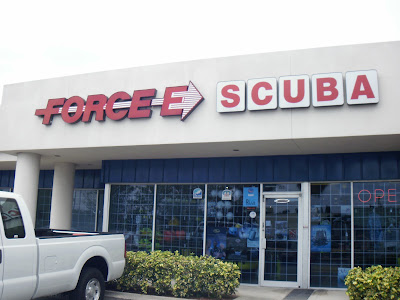I finally got around to writing up a review for the Blue Heron Bridge dive I did while on
my family vacation a month and a half ago. Hey, better late than never, right?
The Blue Heron Bridge is located in Riviera Beach, FL at
Phil Foster Park. This is a public park with free access, parking, restrooms, playground, boat ramp, picnic tables, and a fresh water shower to rinse gear after your dive.
The best time to dive the Blue Heron Bridge is during high tide. The best visibility, least current, and best photo opportunities will be from an hour before high tide to an hour after high tide. This gives you a 2 hour window to explore the 2 different dive sites under the bridge. Check the
Port of Palm Beach tide chart before you go, or stop by
Force-E Scuba on Blue Heron Blvd. to plan your dive. A dive flag is required when diving or snorkeling the Blue Heron Bridge.
Palm Beach County requires a permit for night diving at the Blue Heron Bridge. Most of the area dive shops have these permits, and schedule night dives around once a month.
 |
| The beach under the bridge |
There are 2 sites you will want to explore during your dive. The max depth will be less than 20 feet, so you will have plenty of time to explore both sites on a one tank dive. We started with the west side of the park.
 |
| The view of your easy beach entry |
After entering the water (viewing photo above), head to your right to the west site. Here you will find bridge pilings where lobsters like to hang out. Take your time, and keep your eyes open, you never know what you may find. I have seen starfish, lobsters, stingrays, eels, even an octopus both times I dove here. Be careful to stay out of the main boating channel further west.
 |
| SCUBA Mom |
Not a diver? That's okay, even Mom can snorkel this site. This is as easy as shore diving gets, so there's no reason not to try it!
 |
| Me |
 |
| Group photo |
We saw a lot of lobsters here. The Blue Heron Bridge is a designated "no-take zone"... Too bad some people don't follow the rules (notice the lobster carcass above).
 |
| Bring a dive light to look in tight places. You never know what you may find. |
I can't stress this enough, TAKE YOUR TIME & LOOK CLOSELY!
 |
| Octopus |
 |
| Take your time... Look closely, or you'll miss it. |
The east side of the bridge has a group of sunken shopping carts, and a boat wreck in 12 feet of water that is loaded with fish waiting for you to explore.
To get to the boat wreck from the entry point under the bridge (as pictured above) head out to the left. you will notice a buoy that is tied of to the sunken boat. The shopping carts are located nearby.
A group of new divers was sitting, standing, and touching everything at this site, and managed mess up the vis for everybody else. Please watch your buoyancy here.
The Blue Heron Bridge is a very popular site for underwater macro photography. Check out some of the
photos taken here.
I have been a certified Advanced Open Water / Enriched Air Nitrox SCUBA diver for over 7 years, and have been diving all over the state of Florida, and in The Bahamas. The Blue Heron Bridge IS the best shore dive I have ever done. Get out there and dive it!
[
UPDATE: As of August 2012, the new artificial reef & snorkel trail is open. More info can be found on the
Palm Beach County website.]
That's all for this time. Thanks for reading. Please subscribe,
follow, comment, and
share.
73CZH3YHMSN4












































